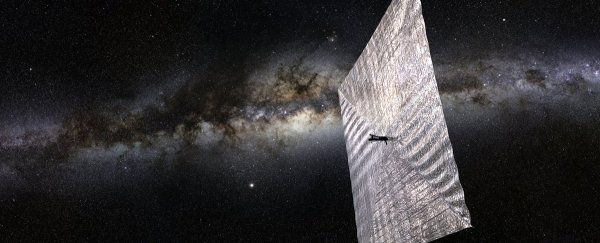LightSail, the solar-powered spacecraft funded by members of Bill Nye's Planetary Society, has successfully deployed its solar-powered sail after overcoming a battery glitch. It's a huge relief for the Planetary Society team and its followers after concerns that the CubeSat wasn't getting enough power to fully unfurl its large sheet of aluminium-coated Mylar plastic film.
That 32-square metre sheet is crucial to the ongoing success of the LightSail mission. It catches the Sun's energy and uses the momentum in its photons to propel itself forward - it's literally sailing on sunlight in the same way that a boat would sail on the wind. The command pod containing the sheet and all LightSail's electronics is about the size of a loaf of bread (30cm by 10cm).
Last week the launch team discovered LightSail's solar panels hadn't charged up the batteries sufficiently, and as a result there wasn't enough energy to deploy the main sail. As the batteries went into a safe mode state of sleep, the problem was compounded, with operators on the ground unable to make contact with the miniaturised satellite.
It turns out this problem was probably due to a "power ping-pong" where the battery power levels were too low in the Earth's shadow and too high in direct sunlight. Analysis is still ongoing, but whatever the issue was, LightSail has come back to life and successfully unfurled its main sheet.
"Sail deployment began at 3:47pm EDT (19:47 UTC) off the coast of Baja California, Mexico, as the spacecraft traveled northwest to southeast," announced the Planetary Society on its blog. The team is expecting to make contact with the LightSail again at some point on Monday as it flies back into view. Based on power levels, camera activity and the sail motor, it appears everything is working as expected.
The main aim of LightSail is to test its technology for future deployments: it's intended to pave the way for low-cost, citizen-funded access to space and space projects. If the solar-powered prototype proves to be a success then it could usher in a new wave of similar projects run by organisations and amateurs without access to the funds or equipment that a large agency like NASA has.
Further down the line, many see solar sailing technology as our best chance of being able to travel long distances through space without huge amounts of fuel. While only small amounts of energy can be transferred from the Sun's rays, it accumulates over time, enabling high-speed travel. A more ambitious flight with a new LightSail travelling on board the SpaceX Falcon Heavy rocket is scheduled in 2016.
The Planetary Society is encouraging everyone to track and report sightings of LightSail as it passes over the Earth - you can find full details of how to do so on the organisation's blog.
